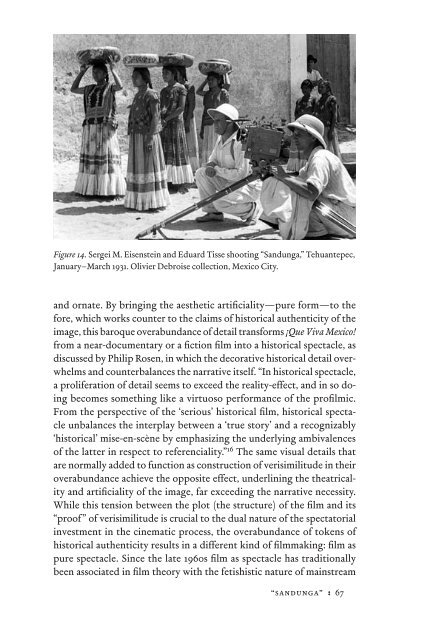In Excess: Sergei Eisentein's Mexico - Cineclub
In Excess: Sergei Eisentein's Mexico - Cineclub
In Excess: Sergei Eisentein's Mexico - Cineclub
Create successful ePaper yourself
Turn your PDF publications into a flip-book with our unique Google optimized e-Paper software.
Figure 14. <strong>Sergei</strong> M. Eisenstein and Eduard Tisse shooting “Sandunga,” Tehuantepec,<br />
January–March 1931. Olivier Debroise collection, <strong>Mexico</strong> City.<br />
and ornate. By bringing the aesthetic artifi ciality—pure form—to the<br />
fore, which works counter to the claims of historical authenticity of the<br />
image, this baroque overabundance of detail transforms ¡Que Viva <strong>Mexico</strong>!<br />
from a near-documentary or a fi ction fi lm into a historical spectacle, as<br />
discussed by Philip Rosen, in which the decorative historical detail overwhelms<br />
and counterbalances the narrative itself. “<strong>In</strong> historical spectacle,<br />
a proliferation of detail seems to exceed the reality-effect, and in so doing<br />
becomes something like a virtuoso performance of the profi lmic.<br />
From the perspective of the ‘serious’ historical fi lm, historical spectacle<br />
unbalances the interplay between a ‘true story’ and a recognizably<br />
‘historical’ mise-en-scène by emphasizing the underlying ambivalences<br />
of the latter in respect to referenciality.” 16 The same visual details that<br />
are normally added to function as construction of verisimilitude in their<br />
overabundance achieve the opposite effect, underlining the theatricality<br />
and artifi ciality of the image, far exceeding the narrative necessity.<br />
While this tension between the plot (the structure) of the fi lm and its<br />
“proof ” of verisimilitude is crucial to the dual nature of the spectatorial<br />
investment in the cinematic process, the overabundance of tokens of<br />
historical authenticity results in a different kind of fi lmmaking: fi lm as<br />
pure spectacle. Since the late 1960s fi lm as spectacle has traditionally<br />
been associated in fi lm theory with the fetishistic nature of mainstream<br />
“sandunga” : 67


